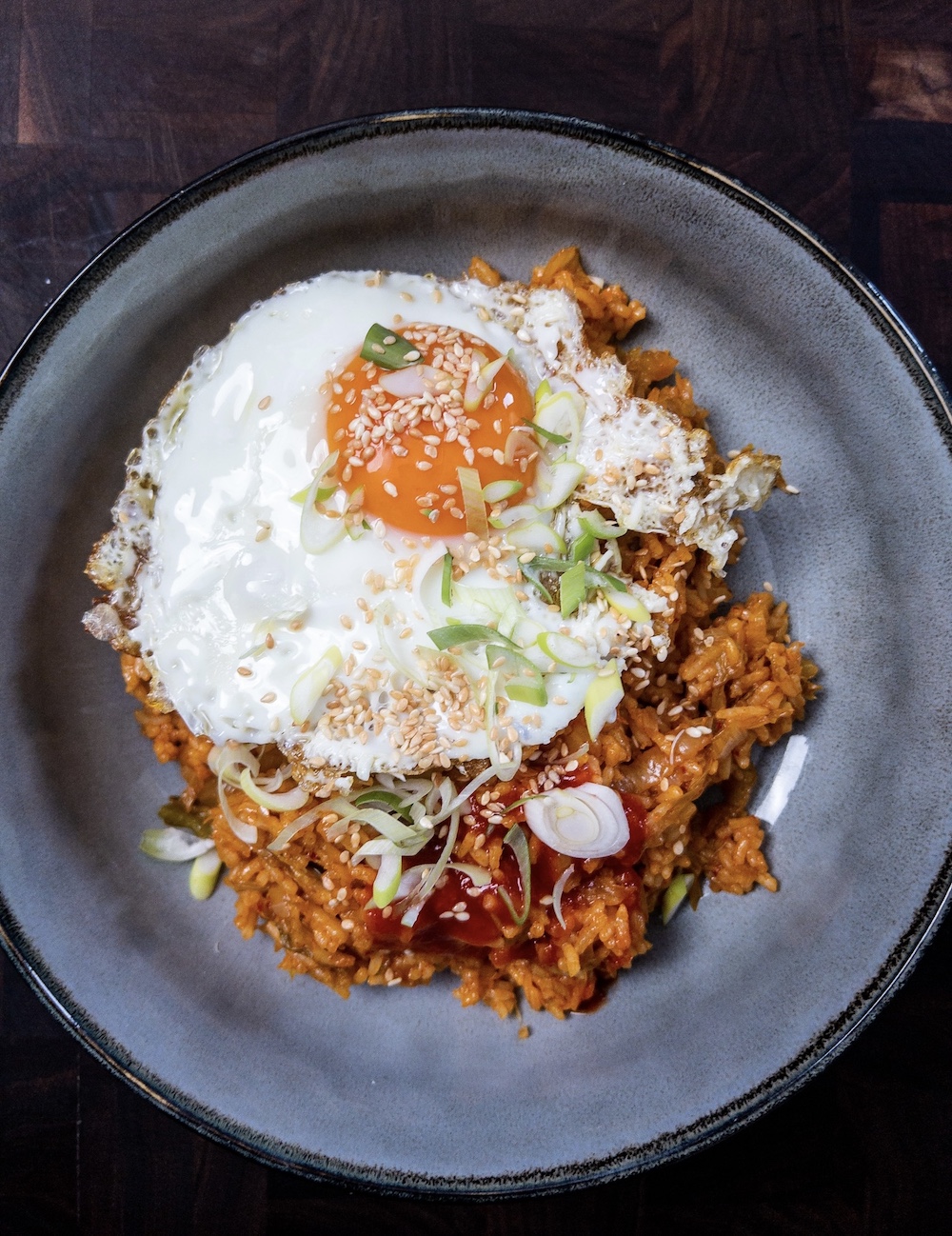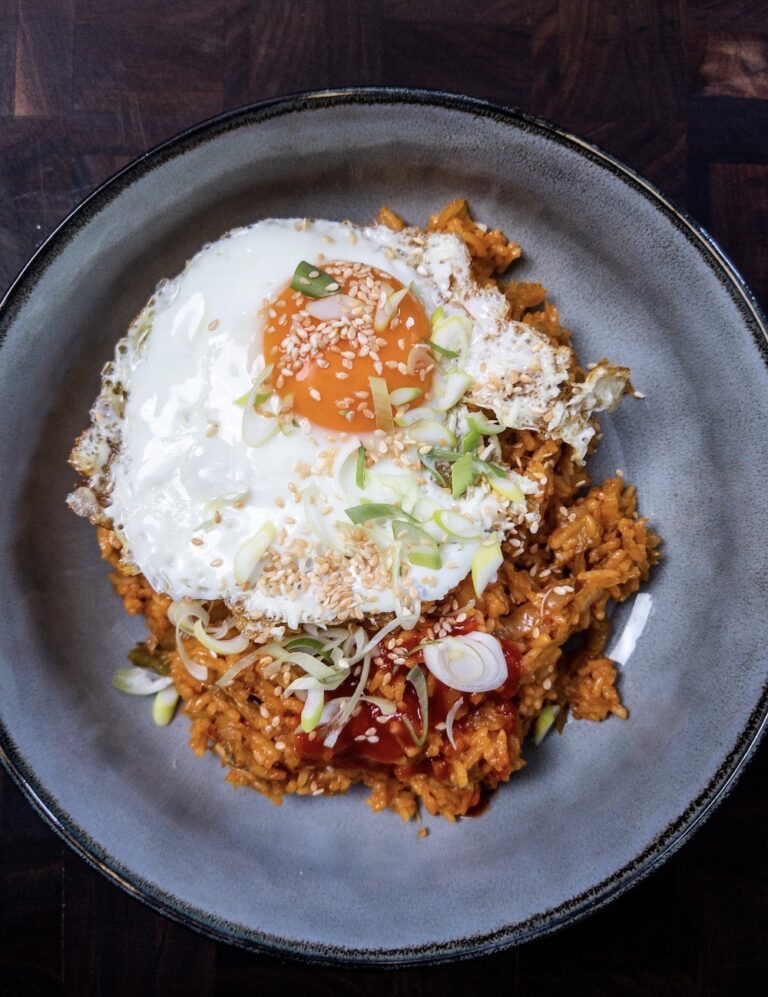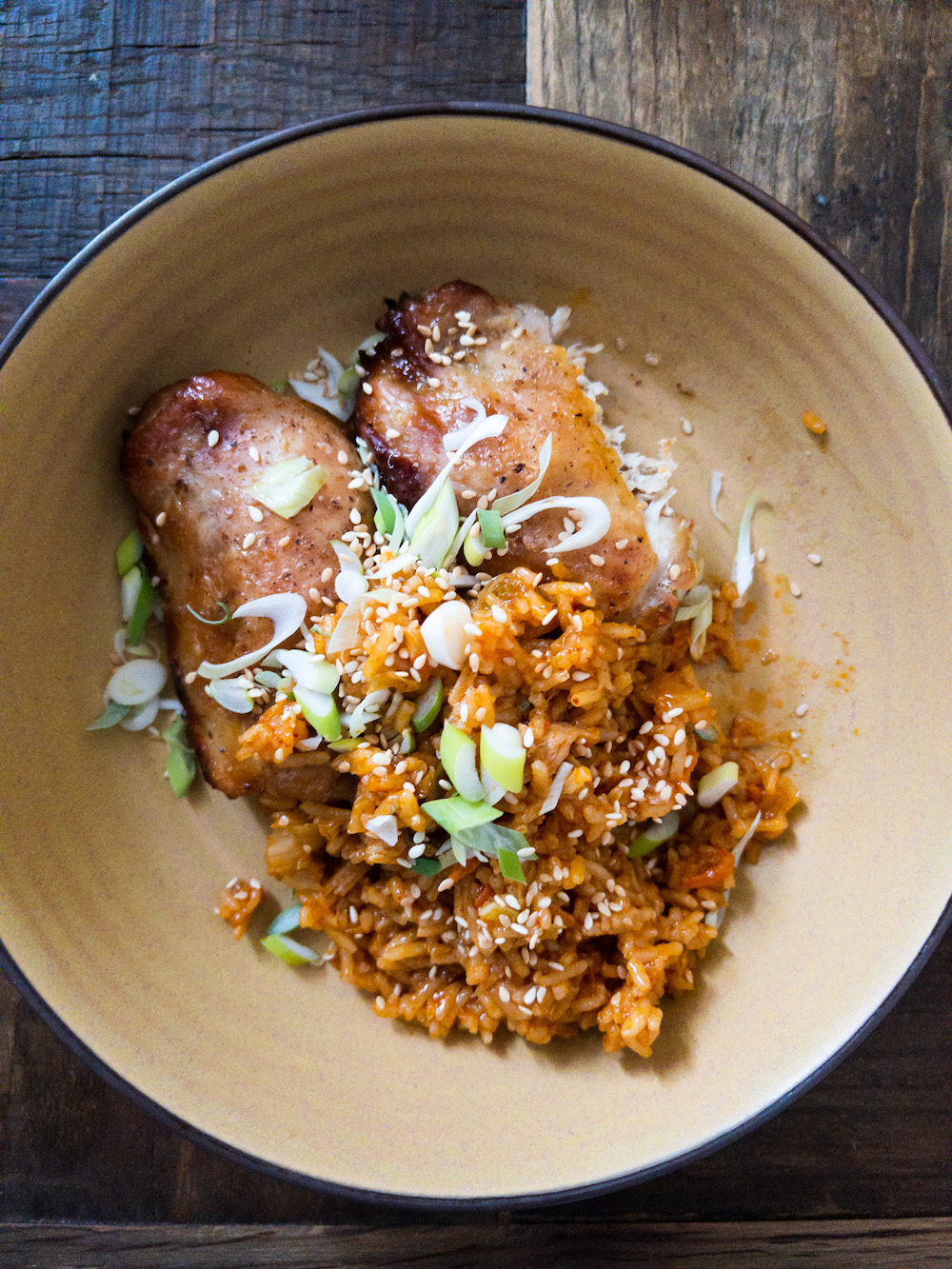Kimchi fried rice has become incredibly popular recently. It’s even ended up in my local riverside café! You can probably ‘blame’ social media food creators for the rise in popularity, myself included.
But the real reason is that it’s absolutely delicious. And the good news is it’s easy for you to make. This could turn out to be your new favourite thing 🙂

This scrumptious meal combines the tangy, spicy goodness of kimchi with the comforting, satisfying texture of fried rice to create a delightful flavor and texture combo.
In this article, we’ll be exploring the ins and outs of this dish, answering your burning questions, and diving into the various aspects of this delicious dish. From health and nutrition to ingredients and preparation, as well as the history and some serving suggestions, I’ve got you covered. So, buckle up and get ready for a flavourful adventure!
Health & Nutrition
Is kimchi fried rice healthy?
My view of healthy food is that if you make yourslef, you’re 90% of the way there. Kimchi, the star ingredient, is a fermented food packed with probiotics, vitamins, and minerals that are great for gut health and digestion [1]. Many people find that white rice, rather than brown is easier to digest. Use organic ingredients where possible.
Is kimchi fried rice good for weight loss?
Kimchi fried rice can be a part of a weight loss diet if consumed in moderation and prepared with fresh ingredients (no processed nasties). By not going crazy with the oil and using healthy fats such as olive oil or avoado oil, or tallow you’ll avoid inflammation from seed oils. By incorporating lean proteins and vegetables, you can create a filling, nutrient-dense meal that is lower in calories. Remember, portion control is key when aiming for weight loss.
Is kimchi fried rice vegetarian or vegan?
Traditionally it often contains meat, fish sauce, or shrimp paste, making it unsuitable for vegetarians or vegans. However, you can easily modify the recipe by omitting animal-based ingredients and using vegetable stock, tamari, or vegan fish sauce as a substitute. There are also vegan kimchi options available on the market that do not contain fish-derived ingredients.
Is kimchi fried rice gluten-free or halal?
It can be made gluten-free by using gluten-free soy sauce or tamari instead of regular soy sauce. As for halal, it depends on the ingredients used. Traditional kimchi often contains fish sauce or shrimp paste, which may not be halal. Look for halal-certified kimchi or make your own using halal ingredients. Additionally, ensure that any meat used in the recipe is halal.
Does kimchi fried rice have meat, egg, seafood, or pork?
Recipes can vary greatly, with some including meat (such as pork or bacon), egg, or seafood. However, the dish can be easily customized to cater to individual dietary preferences or restrictions. Feel free to get creative and experiment with different proteins or make a vegetarian version by substituting meat with tofu or extra vegetables.
Taste & Flavour
Is kimchi fried rice spicy or sour?
This dish offers a delightful combination of flavours that can be spicy, sour, and absolutely delicious. The spiciness mainly comes from the kimchi and gochujang (Korean red pepper paste), while the sourness is a result of the fermentation process of the kimchi. When combined with rice, vegetables, and other ingredients, it transforms into a scrumptious dish that offers a somewhat surprising blend of flavours and textures.
What does kimchi fried rice taste like?
The taste of is a delightful medley of flavours that can be described as spicy, tangy, savoury, and slightly sweet. The fermented kimchi provides a unique tanginess and depth of flavour, while the gochujang and soy sauce contribute to the spiciness and umami taste. Rice, as the base of the dish, soaks up all these flavours and creates a satisfying, hearty meal. The addition of other ingredients like vegetables, proteins, and toppings can further enhance the flavour profile .
Does kimchi fried rice need gochujang or soy sauce?
Gochujang and soy sauce are common ingredients in this idsh that add spiciness and umami. However, the level of spiciness and flavor can be adjusted according to personal preference. If you prefer a milder taste, you can reduce or skip the gochujang, and if you’re looking for a gluten-free or less salty alternative, you can replace soy sauce with tamari or coconut aminos. Ultimately, it’s all about finding the right balance of flavors that suits your taste buds.
Ingredients and Preparation
What is kimchi fried rice made of?
It’s primarily made of cooked rice, kimchi, gochujang (Korean red pepper paste), and soy sauce. Additional ingredients can include vegetables, proteins, and various toppings. The dish can be customized to cater to different dietary preferences and taste buds.
Print
Kimchi Fried Rice
- Total Time: 25 minutes
- Yield: 2 1x
Ingredients
- 1 tbsp coconut oil
- 1 onion (finely diced)
- 1 clove garlic (minced)
- 1 tsp ginger (minced)
- 2 tbsp gochujang
- 250 g kimchi (1 cup)
- 1 tsp tamari
- 1/4 tsp sesame oil (toasted)
- 200 g rice (weighed dry) (I prefer long grain rice) (1 cup)
- 60 ml kimchi juice (strained from the kimchi) (1/4 cup)
- 1 tbsp sesame seeds (toasted)
- 1 spring onion (finely sliced)
- 2 eggs (fried or poached)
Instructions
- Cook your rice according to the instructions on the packet.
- Heat the coconut oil in a pan to a medium heat. Add the onion, garlic and ginger. Cook for 3 minutes until the onions have become translucent.
- Add the gochujang and cook for 2 minutes
- Chop the kimchi and add to the pan with the tamari & sesame oil and cook for a further 3 minutes.
- Add the rice
- Transfer to two plates and top each with a poached or fried egg, shredded nori, spring onion and toasted sesame seeds.
Notes
- Use day-old rice: Freshly cooked rice can be too soft and sticky. Day-old rice has a firmer texture that works better for fried rice dishes.
- Choose the right type of kimchi: Look for well-fermented kimchi with a tangy, sour flavor for a more authentic taste. Ideally get one without any added sugar.
- Optional add-ins and variations: Get creative with your kimchi fried rice by incorporating different vegetables, proteins, or toppings like enoki mushrooms, tofu, or even cheese.
- Prep Time: 10 minutes
- Cook Time: 15 minutes
- Category: dinner
- Cuisine: korean
Nutrition
- Calories: 559
- Sugar: 4
- Sodium: 242
- Fat: 14
- Saturated Fat: 8
- Carbohydrates: 92
- Fiber: 3
- Protein: 15
- Cholesterol: 164
Vegetarian kimchi fried rice:
Follow my recipe, making sure to use vegan kimchi and omitting any meat-based toppings. You can add tofu, tempeh, or your favourite plant-based protein for a satisfying vegetarian meal.
Spam kimchi fried rice:
Please don’t.
Bacon kimchi fried rice:
Follow my recipe, replacing coconut oil with bacon fat. Cook 4-6 strips of bacon in the pan until crispy, then remove and chop. Set aside the bacon bits and proceed with the recipe using the bacon fat. Add the bacon bits back in with the kimchi in step 4.
Last night I whipped this up with the leftovers…

- Cooked up some skin-on chicken thigh in the slow cooker with lemon, salt & pepper.
- When they were done I transferred them to the air fryer to crisp up the skin.
- Whilst that was happening I put the rice in the slow cooker on high to warm up. It soaks up all the juices from the chicken and is out of this world tasty.
History and Origins
When was kimchi fried rice invented?
The exact date of when kimchi fried rice was invented is unclear, as it likely evolved over time as a result of various culinary influences and the availability of ingredients. However, the origins of kimchi itself can be traced back to as early as the Three Kingdoms Period (37 BCE–7 CE) in Korea [2]. Fried rice dishes have been a staple in Asian cuisine for centuries, with each culture developing their unique variations.
Who invented or made kimchi fried rice?
It is difficult to pinpoint a specific person who invented the recipe, as it is a traditional dish that has evolved over time in Korean cuisine. The dish likely emerged as a practical and delicious way to use up leftover rice and kimchi, two staple ingredients in Korean households. The combination of these ingredients, along with the influence of Korean flavors and culinary techniques, led to the creation of the popular dish we know and enjoy today.
Pairing and Serving Suggestions
What goes with kimchi fried rice?
It can be enjoyed on its own or paired with a variety of side dishes and proteins to create a well-rounded meal. Some popular pairings include:
- Korean BBQ dishes, such as bulgogi or galbi
- Stir-fried or steamed vegetables, like bok choy or spinach
- Tofu, tempeh, or other plant-based proteins for a vegetarian option
- Korean side dishes (banchan), such as pickled radish, seasoned bean sprouts, or seaweed salad
What to eat kimchi fried rice with?
As mentioned earlier, it can be served with a variety of side dishes and proteins. You can also pair it with a simple green salad or a bowl of miso soup for a lighter accompaniment. The dish is really versatile, so feel free to mix and match your favorite sides to create a meal that suits your taste buds.
Korean fried rice vs. kimchi fried rice
Korean fried rice, also known as bokkeumbap, is a general term that refers to fried rice dishes in Korean cuisine. Kimchi fried rice (kimchi bokkeumbap) is a specific type of Korean fried rice that features kimchi as the main ingredient. While both dishes share similarities in their preparation and base ingredients, kimchi fried rice has a unique flavor profile due to the tangy, spicy, and savory characteristics of kimchi.
Topping options
The final dish can be garnished with a variety of toppings to enhance its flavours and presentation. Some popular options include:
- Fried egg: A sunny-side-up or over-easy fried egg adds richness and creaminess to the dish.
- Green onions: Thinly sliced green onions provide a fresh, mild onion flavor and a pop of color.
- Sesame seeds: Toasted black or white sesame seeds add a subtle nuttiness and an appealing texture.
- Nori strips or seaweed flakes: These can add a touch of umami and a pleasing crunch to the dish.
- Additional protein: Cooked and sliced proteins, such as chicken, beef, shrimp, or tofu, can be used as toppings or mixed into the rice for a heartier meal.
Feel free to get creative with your toppings and customize to your liking.
Kimchi fried rice near me
To find this dish at a restaurant near you, simply search online for “kimchi fried rice near me” or “Korean restaurants near me.” You can also look for restaurants that specialize in Asian fusion cuisine, as many of them may offer their unique take on it.
Korean grocery stores
For those who prefer to make kimchi fried rice at home, Korean grocery stores are a great place to find authentic ingredients like kimchi, gochujang, and short-grain rice. Some well-stocked mainstream grocery stores may also carry these items in their international or Asian food sections.
Kimchi Fried Rice UK
Here is a list of some restaurants in the UK where you can enjoy this delicious dish:
- On the Bab (London) – A popular Korean street food restaurant with multiple locations in London. Website: https://www.onthebab.com/
- Kimchi Cult! (Glasgow) – A Korean-style fast-food eatery in Glasgow, offering a variety of dishes. Website: https://www.kimchicult.com/
- Topokki (Birmingham) – A casual Korean restaurant in Birmingham with a diverse menu. Website: https://www.topokki.co.uk/
- Oisoi (Sheffield) – An Asian fusion restaurant in Sheffield offering a range of dishes, including Korean-inspired version. Website: https://oisoi.co.uk/
- Yori (London) – A Korean barbecue restaurant in London, offering an authentic version of the dish as part of their extensive menu. Website: https://www.yori.co.uk/
- Tofu Vegan & Korean Restaurant (Edinburgh) – A vegan and Korean restaurant in Edinburgh with a diverse menu, including a vegetarian option. Website: https://www.tofurestaurant.co.uk/
Please note that menus might change, and it’s always a good idea to check with the restaurant beforehand to ensure they still offer kimchi fried rice. Additionally, you can always search online for more options or explore other Korean restaurants in your area, as many of them may serve this popular dish.
Storage and Shelf Life
Does kimchi fried rice go bad? Can kimchi fried rice go bad?
Like any other cooked dish, it can go bad if not stored properly. Over time, the rice and other ingredients can spoil, resulting in an unpleasant taste and texture or even foodborne illness. As a general rule, it will keep in the fridge for up to 3-4 days.
How to store kimchi fried rice properly
To store leftovers, follow these steps:
- Allow it to cool down to room temperature.
- Transfer to an airtight container.
- Store the container in the refrigerator for up to 3-4 days.
- When reheating the, use astovetop, ensuring that the rice is heated through to a safe internal temperature of at least 74°C (165°F) before consuming.
Since you’re here you may have already had kimchi fried rice and want to know how to make it yourself. But if you’ve yet to try it, I highly suggest getting a good, authentic try of it first. Let me know how you get on with this recipe in the comments.
References
[1] Leuconostoc mesenteroides and Lactobacillus brevis are two of the main probiotic strains found in kimchi, which contribute to its beneficial effects on gut health and digestion. The fermentation process of kimchi also enhances the bioavailability of nutrients, including vitamins and minerals.
Reference:
Park, K.Y., Jeong, J.K., Lee, Y.E., & Daily, J.W. 3rd (2014). Health benefits of kimchi (Korean fermented vegetables) as a probiotic food. Journal of Medicinal Food, 17(1), 6-20. doi: 10.1089/jmf.2013.3083
Link: https://pubmed.ncbi.nlm.nih.gov/24456350/
[2] Kimchi, as a fermented vegetable dish, can be traced back to the Three Kingdoms Period (37 BCE–7 CE) in Korea. Its development and transformation over time have been influenced by various factors, including agriculture, social and cultural changes, and foreign interactions.
Reference:
Park, C., & Park, Y. (2018). The Basic Study on the Development and Transformation of Kimchi. Journal of Ethnic Foods, 5(1), 1-8. doi: 10.1016/j.jef.2017.12.002
